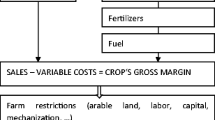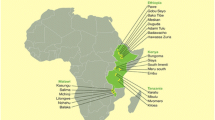Abstract
This study uses farm models to analyze the effect of farm size on farm-level costs of adoption of reduced soil cultivation systems. In an empirical study in the Kulunda Steppe in Russia, we examine the farm-level economics of three crop cultivation technologies: old Soviet intensive tillage technology (OS), modified Soviet reduced-tillage technology (MS), and modern Canadian no-till technology (MC). We consider economies of size by considering three farm sizes (small = 500 ha, medium = 5000 ha, and large = 15,000 ha). Based on the general approach to cost and activity accounting, we sequentially compute gross cost–benefit measurement to assess the economic performance of the different systems. The study utilizes two data sources: (1) experts’ estimates regarding the input requirements and yield impacts of reduced-tillage systems in the marginal ecosystem of the Kulunda Steppe and (2) market prices in 2014 and 2015. According to the model calculations, OS is inferior to MC and MS tillage systems in all farm sizes if we adopt a medium- to long-term perspective and consider residual income. If we adopt a very short-term perspective and consider only the difference between sales and direct costs, the MC tillage system would rank first across all modeled farm sizes. However, because farms in the Kulunda Steppe are heterogeneous, our results cannot replace management decisions based on farm-specific calculations that consider the conditions of the respective farm.
Similar content being viewed by others
Notes
Dr. Meinel has studied soil cultivation in the Altai krai for approximately 15 years.
Prof. Belayev (Professor at the Farm Mechanisation Department at the Agrarian University in Barnaul) has investigated soil cultivation technologies in Altai krai for two decades.
With regard to machinery requirement for follow, it must be noted that the mechanical follow is cultivated six times during the vegetation period: once using a deep cultivation and five times using flat cultivation by harrow.
As mentioned previously, machinery prices have changed significantly due to the depreciation of the Russian ruble. Thus, machinery costs were calculated based on the exchange rates that prevailed before (40 RUB/€ exchange rate) and after the crisis (60 RUB/€ exchange rate). However, only the more current results are presented here. Data regarding the cost of machinery before the exchange rate crisis are available upon request.
The bank interest rate on the purchase of both imported and Russian machines is 12%.
OS is the conventional technology that usually uses Russian machinery. We therefore assume Russian machinery equipment when calculating the costs of OS.
Similar results were also obtained using the pre-crisis exchange rate (40 €/RUB), although residual income with the pre-crisis exchange rate is higher than residual income with the exchange rate that prevailed during the crisis (60 €/RUB). These results are available upon request.
A total of 92 farms were investigated in the Altai Krai between February 2015 and July 2016. We collected the data through quantitative face-to-face questionnaire surveys. When selecting the farms, our aim was to have at least one large and medium or small farm from each rayon in our sample. We closely achieved this aim as we covered 52 rayons from 59.
References
Agroserver. (2015). Rosiyskiy agorpromishlenniy server. Retrieved April 9, 2018 www.agroserver.ru.
Baudron, F., Corbeels, M., Andersson, J. A., Sibanda, M., & Giller, K. E. (2011). Delineating the drivers of waning wildlife habitat: The predominance of cotton farming on the fringe of protected areas in the Zambezi Valley, Zimbabwe. Biological Conservation, 144(5), 1481–1493.
Bavorova, M., Imamverdiyev, N., & Ponkina, E. (2018). Farm-level economics of innovative tillage technologies: The case of no-till in the Altai Krai in Russian Siberia. Environmental Science and Pollution Research, 25(2), 1016–1032.
Becker, C. (1997). Dauerhaft pfluglose Bodenbearbeitungssysteme und Betriebsgröße – eine pflauzenbaulich-ökonomische Analyse. Dissertation, Georg-Auguns-Universität Göttingen.
Bednaříková, Z., Bavorová, M., & Ponkina, E. V. (2016). Migration motivation of agriculturally educated rural youth: The case of Russian Siberia. Journal of Rural Studies, 45, 99–111.
D’Emden, F. H., Llewellyn, R. S., & Burton, M. P. (2008). Factors influencing adoption of conservation tillage in Australian cropping regions. Australian Journal of Agricultural and Resource Economics, 52(2), 169–182.
Dammann, S., Meinel, T., Beljaev, V. I., & Frühauf, M. (2011). Einfluss verschiedener Bodenbearbeitungsmethoden auf Bodenwasserhaushalt und Pflanzenproduktion in Trockengebieten. Hallesches Jahrbuch für Geowissenschaften, 32(33), 33–48.
D’Emden, F. H., Llewellyn, R. S., & Burton, M. P. (2006). Adoption of conservation tillage in Australian cropping regions: An application of duration analysis. Technological Forecasting and Social Change, 73, 630–647.
FAO. (2015). What is conservation agriculture? Retrieved September 2, 2018 http://www.fao.org/ag/ca/1a.html.
Fowler, R., & Rockstrom, J. (2001). Conservation tillage for sustainable agriculture: An agrarian revolution gathers momentum in Africa. Soil and Tillage Research, 61(1), 93–108.
Frühauf, M. (2013). KULUNDA—How to prevent the next “Global Dust Bowl”? Retrieved August 5, 2016 http://www.youtube.com/watch?v=1E3kpFIQTWA.
Fuglie, K. O., & Kascak, C. A. (2001). Adoption and diffusion of natural-resource-conserving agricultural technology’. Review of Agricultural Economics, 23, 386–403.
Giller, K. E., Witter, E., Corbeels, M., & Tittonell, P. (2009). Conservation agriculture and smallholder farming in Africa: The heretics’ view. Field Crops Research, 114(1), 23–34.
Gray, R. S., Taylor, J. S., & Brown, W. J. (1996). Economic factors contributing to the adoption of reduced tillage technologies in central Saskatchewan. Canadian Journal of Plant Science, 76(4), 661–668.
Hanemann, W. M. (1991). Willingness to pay and willingness to accept: How much can they differ? The American Economic Review, 81(3), 635–647.
Hernanz, J. L., Giro´n, V. S., & Cerisola, C. (1995). Long-term energy use and economic evaluation of three tillage systems for cereal and legume production in central Spain. Soil and Tillage Research, 35(4), 183–198.
Karakulev, V. V., Bakirov, F. G., & Vibe, V. D. (2004). Effektivnost’ resursosberegayushchikh sistem osnovnoy obrabotki pochvy pri vozdelyvanii yarovoy pshenitsy (Vol. 4, pp. 14–16). Orenburg: Izvestiya Orenburgskogo gosudarstvennogo agrarnogo universiteta.
Kassam, A., Friedrich, T., Derpsch, R., & Kienzle, J. (2015). Overview of the worldwide spread of conservation agriculture. Field actions science reports. The Journal of Field Actions Science Reports, 8, 1–11.
Knowler, D., & Bradshaw, B. (2007). Farmers’ adoption of conservation agriculture: A review and synthesis of recent research. Food Policy, 32(1), 25–48.
Llewellyn, R. S., D’Emden, F. H., & Kuehne, G. (2012). Extensive use of no-tillage in grain growing regions of Australia. Field Crops Research, 132, 204–212.
Llewellyn, R., & D’Emden, F. (2010). Successful adoption down under. In W. Lindwall & B. Sonntag (Eds.), Landscape transformed: The history of conservation tillage and direct seeding (pp. 163–172). Saskatoon: Knowledge Impact in Society.
López, M. V., Sabre, M., Gracia, R., Arrúe, J. L., & Gomes, L. (1998). Tillage effects on soil surface conditions and dust emission by wind erosion in semi-arid Aragón (NE Spain). Soil & Tillage Research, 45, 91–105.
Markovskaya, G. K., & Yudina, V. (2009). Vliyaniye razlichnykh sposobov osnovnoy obrabotki pochvy na yeye biologicheskuyu aktivnost’ v usloviyakh lesostepnoy zony samarskoy oblasti. Dostizheniya Nauki i Tekhniki APK, 3, 21–23.
Meinel, T., 2002. Die geoökologischen Folgewirkungen der Steppenumbrüche in den 50er Jahren in Westsibirien. Ein Beitrag für zukünftige Nutzungskonzepte unter besonderer Berücksichtigung der Winderosion. Dissertation, Martin-Luther-Universität Halle-Wittenberg.
Meinel, T. (2012). Major trials KULUNDA 2013–2017. Unpublished.
Meyer-Aurich, A., Janovicek, K., Deen, W., & Weersink, A. (2006). Impact of tillage and rotation on yield and economic performance in corn-based cropping systems. Agronomy Journal, 98(5), 1204–1212.
Ozpinar, S., & Ozpinar, A. (2011). Influence of tillage and crop rotation systems on economy and weed density in semi-arid region. Journal of Agricultural Science and Technology, 13, 769–784.
Pannell, D. J., Llewellyn, R. S., & Corbeels, M. (2014). The farm-level economics of conservation agriculture for resource-poor farmers. Agriculture, Ecosystems & Environment, 187, 52–64.
Polyanskaya, N. A. (2012). Povysheniye effektivnosti proizvodstva zerna na osnove resursosberegayushchikh tekhnologiy. Vestnik NGIEI, 5, 77–93.
Pykhtin, I. G., & Gostev, A. V. (2012). Sovremennyye problemy primeneniya razlichnykh sistem i sposobov osnovnoy obrabotki pochvy. Dostizheniya nauki i tekhniki APK, 1, 3–5.
Raper, R. L., Reeves, E. W., Burt, E. C., & Torbert, H. A. (1994). Conservation tillage and traffic effects on soil conditions. Transaction of the ASAE, 37(3), 763–768.
REESTR. (2012–2015). Reestr selskohozyaystvennyih predpriyatiy. 2012-2015. Upravlenie selskogo hozyaystva Altayskogo kraya. (Reestr of Agricultural Enterptises in Altai Krai. The Main Department of Agrikulture in Altai Krai). Retrieved July 24, 2019 http://www.altagro22.ru/management/docs/?ELEMENT_ID=52075.
Rosagroleasing. (2015). Yediny prays list na tekhniku po federal’nomu lizingu. Retrieved November 4, 2018 www.rosagroleasing.ru.
ROSSTAT. (2019). Federalnaya sluzhba gosudarstvennoy statistiki. Edinaya mezhvedomstvennaya informatsionno – statisticheskaya sistema (EMISS). (Federal State Statistics Service. United Informational Statistics System). Retrieved July 24, 2019 http://www.gks.ru/wps/wcm/connect/rosstat_main/rosstat/ru/statistics/databases/emiss/.
Rusinamhodzi, L., Corbeels, M., van Wijk, M., Rufino, M. C., Nyamangara, J., & Giller, K. E. (2011). A meta-analysis of long-term effects of conservation agriculture on maize grain yield under rain-fed conditions. Agronomy for Sustainable Development, 31(4), 657–763.
Sánchez-Girón, V., Serrano, A., Hernanz, J. L., & Navarrete, L. (2004). Economic assessment of three long-term tillage systems for rainfed cereal and legume production in semiarid central Spain. Soil and Tillage Research, 78(1), 35–44.
Sergienko, A.M., Anisimova, M.M., Ivanova, O.A., Perekarenkova, Y.A., Rzaeva, S.V., Reshetnikova S.A., & Rodionova, L.V. (2013). Bednost celskoy Rosii v usloviyach modernizacii ekonomiki: Processy i mechanizmy formirovaniya i preodoleniya. Barnaul.
Shibaeva, E. E. (2012). Russian village in the thick of the demographic crisis: Political aspect. Teoriya i Praktika Obshestvenogo Razvitiya, 9, 198–200.
Singer, J. W., Chase, C. A., & Kohler, K. A. (2010). Profitability of cropping systems featuring tillage and compost. Agronomy Journal, 102(2), 450–456.
Smart, J. R., & Bradford, J. M. (1999). Conservation tillage corn production for a semiarid, subtropical environment. Agronomy Journal, 91(1), 116–121.
Thomas, G. A., Titmarsh, G. W., Freebairn, D. M., & Radford, B. J. (2007). No-tillage and conservation farming practices in grain growing areas of Queensland–a review of 40 years of development. Animal Production Science, 47(8), 887–898.
Ward, B., Smith, D., Shaw, G., Haak, D., & Fredette, J. (2010). Policy and program response to land management issues. In C. Lindwall & B. Sonntag (Eds.), Landscapes transformed: The history of conservation tillage and direct seeding (pp. 15–22). Saskatchewan: Knowledge Impact in Society.
Weersink, A., Walker, M., Swaton, C., & Shaw, J. E. (1992). Cost of conventional and conservation tillage systems. Journal of Soil and Water Conservation, 47(4), 328–334.
Zentner, R. P., Lafond, G. P., Derksen, D. A., & Campbell, C. A. (2002). Economics of crop diversification and soil tillage opportunities in the Canadian prairies. Agronomy Journal, 94(2), 216–230.
Acknowledgements
The authors would like to thank Dr. Tobias Meinel and Lars Grünwald (experts on introduction of no-till system from the agricultural machinery manufacturer Amazon in Kazakhstan and Russia and co-founders of farmers’ extension organization on reduced till introduction in Altai Krai) as well as Prof. Belayev (professor from the Farm Mechanization Department at the Agrarian University in Barnaul and co-founder of farmers’ extension organization on reduced till introduction in Altai Krai) for their valuable estimations. Without their knowledge input, this analysis would not have been possible. The authors acknowledge the KULUNDA Project, part of the BMBF research program ‘Sustainable Land Management’, for completion of this research.
Author information
Authors and Affiliations
Corresponding author
Additional information
Publisher's Note
Springer Nature remains neutral with regard to jurisdictional claims in published maps and institutional affiliations.
Appendix
Appendix
Rights and permissions
About this article
Cite this article
Bavorova, M., Ponkina, E.V., Imamverdiyev, N. et al. Effect of adoption of sustainable crop production systems on farm economics. Environ Dev Sustain 22, 6961–6984 (2020). https://doi.org/10.1007/s10668-019-00522-1
Received:
Accepted:
Published:
Issue Date:
DOI: https://doi.org/10.1007/s10668-019-00522-1




